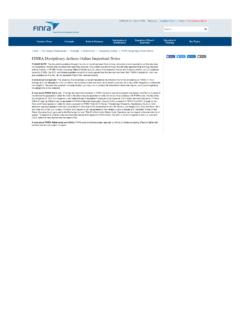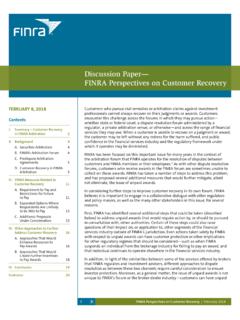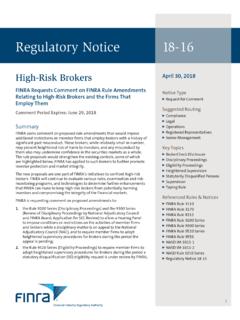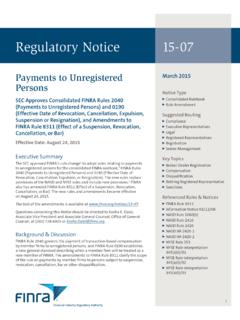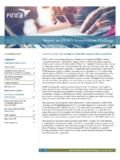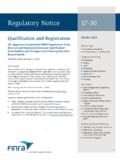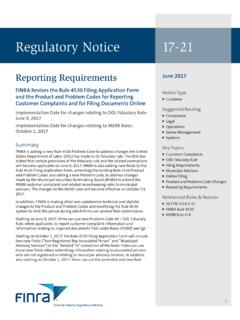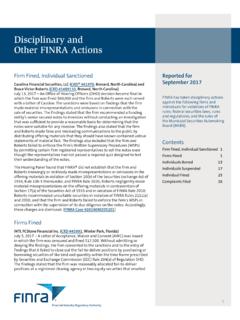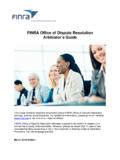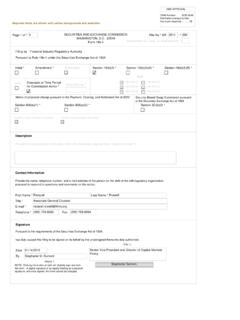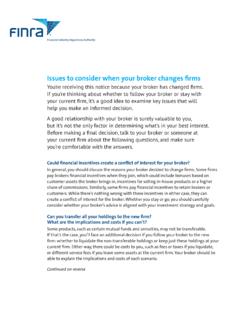Transcription of IntroduuciFoaHgcFih-skoiu oo mBieOuihO-uopsO ...
1 2018 Annual Regulatory and Examination Priorities LetterIntroductionThe 2018 Regulatory and Examination Priorities Letter identifies topics that finra will focus on in the coming year, and these include some new topics as well as others that remain ongoing areas of focus. finra s 2017 Examination Findings Report presents observations on both concerns and effective practices relevant to some of these areas, and finra encourages broker-dealers to use that report and this letter as resources to enhance their compliance, supervisory and risk management programs, and to prepare for their finra is always a major area of focus for finra . Fraudulent activities such as insider trading, microcap pump-and-dump schemes, issuer fraud and Ponzi-type schemes harm investors and damage the integrity of the market. In the past year, finra has made hundreds of referrals to the Securities and Exchange Commission (SEC) for potential insider trading and other fraudulent activities involving individuals or entities outside finra s jurisdiction, and we will continue to pursue our investigations in these areas addition, finra will focus on microcap fraud schemes, including schemes that target senior investors.
2 finra investigations have identified senior investors who have been victimized by unregistered individuals using high-pressure sales tactics as part of a pump-and-dump scheme. Last year s Regulatory and Examination Priorities Letter described controls firms can use to protect elderly investors, and, with the addition of finra s new Rule 2165 and amendments to finra Rule 4512 (discussed later in this document), firms have even more tools to protect senior investors from these types of schemes. In addition, finra reminds firms of their obligation to file a Suspicious Activity Report (SAR) for illicit activity involving the exploitation of senior should be attentive to their brokers activity in microcap stocks, particularly when brokers show a new or sudden interest in buying microcap stocks for their own accounts or those of their customers. finra will investigate brokers who use their own or their customers accounts to coordinate trading in microcap stocks with known or unknown counterparties.
3 Firms should also evaluate internal policies and training regarding permissible communications and interactions with microcap stock promoters to assist in preventing brokers from participating in any fraudulent scheme. High-risk Firms and Brokers 2 Operational and Financial Risks 2 Sales Practice Risks 4 Market Integrity 6 New Rules 9 Conclusion 10 Endnotes 11 January 2018 Topics22018 AnualRegto Rry dERxmrRemgr itmgtmemnP sneentHigh-risk Firms and BrokersBuilding on our work in 2017, a top priority for finra will continue to be identifying high-risk firms and individual brokers and mitigating the potential risks that they can pose to finra will focus on firms hiring and supervisory practices for high-risk brokers, including, for example, firms remote supervision arrangements; supervision of point-of-sale activities, including individual broker accountability when using joint rep codes; and branch inspection programs.
4 finra reminds firms of their existing obligation to adopt and implement tailored heightened supervisory procedures under finra Rule 3110 (Supervision) for high-risk will also continue to focus on the risks that these firms and brokers pose to investors, including unsophisticated or senior investors. For example, we will focus on recommendations for speculative or complex products by high-risk brokers to investors who may not have the necessary sophistication, experience or investment objectives. We will also review situations where registered representatives have control of investors finances as power-of-attorney or trustee on customer accounts, or have future rights to customer assets as a named beneficiary on customer accounts. We will also evaluate rollovers of qualified plans into non-qualified accounts for senior addition, finra will continue to focus on registered representatives who conduct approved private securities transactions by raising funds from investors they serve away from their firm.
5 finra will assess firms ability to monitor the proper use of proceeds from these offerings and whether registered representatives make adequate disclosures about their interest in, control of, or association with the will also continue to review firms controls regarding the outside business activities of registered persons, including to identify instances of settling away where registered representatives borrow money from their customers or make payments to customers from their outside business bank and Financial RisksBusiness Continuity PlanningRecent events such as Hurricanes Harvey and Maria underscore the need for firms to maintain written Business Continuity Plans (BCPs) that address continued access to critical systems, including in situations where firms may not have physical access to locations, potentially for an extended period. finra Rule 4370 requires firms to maintain plans that are reasonably designed to enable them to meet their existing obligations to customers in an emergency or business disruption.
6 finra will review firms BCPs with a focus on their implementation of the plan. For example, we will review how and under what circumstances firms activate their BCPs, how they classify systems as mission-critical or secondary, how they accomplish data backup and recovery, and where applicable, how firms coordinate with their affiliates and vendors during a business continuity situation. We will also review firms plans for restoring systems, procedures and records once they are prepared to return to normal business, as well as how they make those AnualRegto Rry dERxmrRemgr itmgtmemnP sneentCustomer Protection and Verification of Assets and LiabilitiesThe protection of customer assets and the accuracy of firms financial data are perennial priorities in finra s examinations. finra will examine the accuracy of firms net capital and reserve computations under Securities Exchange Act (SEA) Rules 15c3-1 and 15c3-3.
7 In our examination of firms records, we will review their processes for verifying customer assets and proprietary assets and liabilities in those financial records. We may also contact appropriate entities, such as custodial banks, to assess the validity of reported our examination of firms compliance with SEA Rule 15c3-3, we will evaluate whether firms have implemented adequate controls and supervision to protect customer assets and assess their compliance with the specific requirements of the rule ( , whether they properly perform their possession or control calculations). In addition, finra will review whether firms maintain sufficient documentation to demonstrate that securities are held free of liens and encumbrances, especially for securities held at foreign custodians. finra will review whether firms foreign depositories, clearing agencies and custodial banks are good control locations, including whether firms have filed applications with the SEC for such foreign custodial arrangements.
8 We may also look at the underlying arrangements with foreign custodians to determine if they permit cross-liens or use temporary holding accounts. Where customer securities may be held in, or move through, temporary holding accounts, we will consider whether these accounts are good control locations and whether firms have instituted reasonable procedures to monitor them for customer GovernanceFINRA will review firms information and technology change management policies and procedures. Some firms have experienced significant customer service and regulatory problems as a result of operational breakdowns caused by the implementation of new systems as well as enhancements and modifications to existing proprietary or vendor systems. These breakdowns can arise from coding issues, system capacity limitations or other flaws, and may have a significant adverse impact on order entry or execution, data integrity or customer protection.
9 It is critical that firms maintain strong controls over changes to their information technology to prevent inaccurate, incomplete, untested or unauthorized changes to their production environments. These can result in system defects or outages, data inaccuracies or unintended consequences that can negatively affect customers, the firm or the threats remain a significant risk and will continue to be a priority. finra will evaluate the effectiveness of firms cybersecurity programs to protect sensitive information, including personally identifiable information, from both external and internal threats. finra will review firms preparedness, technical defenses and resiliency measures, among other things. Firms should review the Examination Findings Report for additional information about finra s observations regarding concerns and effective practices related to cybersecurity. finra also reminds firms that they must have policies and procedures in place to assess whether to file a SAR when they identify a cybersecurity AnualRegto Rry dERxmrRemgr itmgtmemnP sneentAnti-Money LaunderingFINRA will assess the adequacy of firms anti-money laundering (AML) programs.
10 finra continues to identify concerns related to, for example, the adequacy of (1) firms policies and procedures to detect and report suspicious transactions; (2) resources for AML monitoring; and (3) independent testing required under finra Rule 3310(c). Firms should review the Examination Findings Report to understand finra s areas of concern and observations on effective practices related to AML. In addition to those concerns, firms should be attentive to the potential use of their foreign affiliates to conduct high-risk transactions through accounts at member firms, including in microcap and dual-currency securities. finra has observed situations where firms do not monitor, or may monitor less closely, accounts opened for an affiliate. Firms should also confirm that their AML surveillance programs cover accounts used in connection with securities-backed lines of credit (SBLOCs) and aggregate activity across accounts when they use multiple accounts to receive and disburse funds in connection with an RiskFINRA will continue to focus on firms liquidity planning, compare strengths and weaknesses across firms liquidity plans and share effective practices.
